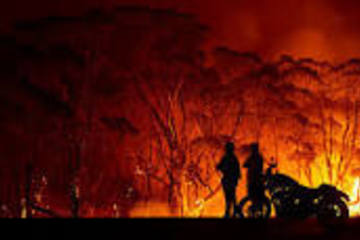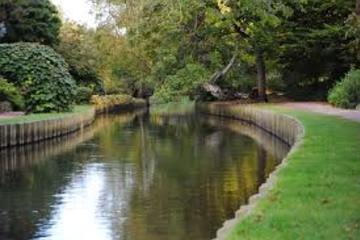We found 7 results that contain "ecosystem"
Posted on: #iteachmsu


Dynamic ecological system measures: A holistic analysis of compartmental systems
The system decomposition theory has recently been developed for the dynamic analysis of nonlinear compartmental systems. The application of this theory to the ecosystem analysis has also been introduced in a separate article. Based on this methodology, multiple new dynamic ecological system measures and indices of matrix, vector, and scalar types are systematically introduced in the present paper. These mathematical system analysis tools are quantitative ecological indicators that monitor the flow distribution and storage organization, quantify the direct, indirect, acyclic, cycling, and transfer (diact) effects and utilities of one compartment on another, identify the system efficiencies and stress, measure the compartmental exposures to system flows, determine the residence times and compartmental activity levels, and ascertain the system resilience and resistance in the case of disturbances. The proposed dynamic system measures and indices, thus, extract detailed information about ecosystems’ characteristics, as well as their functions, properties, behaviors, and various other system attributes that are potentially hidden in and even obscured by data. A dynamic technique for the quantitative characterization and classification of main interspecific interactions and the determination of their strength within food webs is also developed based on the diact effect and utility indices. Moreover, major concepts and quantities in the current static network analyses are also extended to nonlinear dynamic settings and integrated with the proposed dynamic measures and indices in this unifying mathematical framework. Therefore, the proposed methodology enables a holistic view and analysis of ecological systems. We consider that the proposed methodology brings a novel complex system theory to the service of urgent and challenging environmental problems of the day and has the potential to lead the way to a more formalistic ecological science.
NAVIGATING CONTEXT
Posted on: #iteachmsu


Environmental Flows
The natural, seasonal patterns of rising
And falling water levels in freshwater systems shape aquatic and riparian habitats, provide cues for migration and spawning, distribute seeds and foster their growth, and enable rivers, lakes, wetlands, and estuaries to function properly. Altering the natural flow pattern – by damming, diverting or channeling water – takes a serious toll on the plants and animals that depend on it. If natural patterns and volumes of water flow are altered too greatly, freshwater ecosystems and species suffer.
And falling water levels in freshwater systems shape aquatic and riparian habitats, provide cues for migration and spawning, distribute seeds and foster their growth, and enable rivers, lakes, wetlands, and estuaries to function properly. Altering the natural flow pattern – by damming, diverting or channeling water – takes a serious toll on the plants and animals that depend on it. If natural patterns and volumes of water flow are altered too greatly, freshwater ecosystems and species suffer.
Posted on: #iteachmsu


Ecology Ecosystem dynamics and conservations
Through a case study on Mozambique's Gorongosa National Park, learners will explore how scientists study ecosystem
The idea that food webs and ecosystem functioning are intimately linked harkens back at least to the work of Forbes (1887). He pondered, in his lake as a microcosm paper, the complexity of lake ecosystems and how this complexity could be maintained given the complex network of trophic interactions. He also emphasized that spatial structure, both within and among lakes, could be important. Lindeman (1942) built on Forbes’s vision of a food web as a microcosm by linking a simplified view of food webs to ecosystem metabolism. Since then, much thinking has gone into understanding food webs and their links to ecosystem attributes (Odum 1957; Margalef 1963), but until recently the importance of space has not sufficiently been integrated into these thoughts. By contrast, the importance of space to populations and communities has been recognized for some time (Watt 1947; Skellam 1951; MacArthur & Wilson 1967), but the connection between this literature and food webs and ecosystems is only now being resolved (Loreau et al. 2003; Polis et al. 2004; Holt & Hoopes 2005; Pillai et al. 2009; Gravel et al. 2010a). Some progress has been made (e.g. Polis et al. 2004; Holyoak et al. 2005), but most of the work on the spatial food web and ecosystem properties has progressed along with two relatively independent traditions.
REF :links https://onlinelibrary.wiley.com/doi/pdf/10.1111/j.1461-0248.2011.01588.x
YouTube: https://youtu.be/C6YrPt1ygX8
The idea that food webs and ecosystem functioning are intimately linked harkens back at least to the work of Forbes (1887). He pondered, in his lake as a microcosm paper, the complexity of lake ecosystems and how this complexity could be maintained given the complex network of trophic interactions. He also emphasized that spatial structure, both within and among lakes, could be important. Lindeman (1942) built on Forbes’s vision of a food web as a microcosm by linking a simplified view of food webs to ecosystem metabolism. Since then, much thinking has gone into understanding food webs and their links to ecosystem attributes (Odum 1957; Margalef 1963), but until recently the importance of space has not sufficiently been integrated into these thoughts. By contrast, the importance of space to populations and communities has been recognized for some time (Watt 1947; Skellam 1951; MacArthur & Wilson 1967), but the connection between this literature and food webs and ecosystems is only now being resolved (Loreau et al. 2003; Polis et al. 2004; Holt & Hoopes 2005; Pillai et al. 2009; Gravel et al. 2010a). Some progress has been made (e.g. Polis et al. 2004; Holyoak et al. 2005), but most of the work on the spatial food web and ecosystem properties has progressed along with two relatively independent traditions.
REF :links https://onlinelibrary.wiley.com/doi/pdf/10.1111/j.1461-0248.2011.01588.x
YouTube: https://youtu.be/C6YrPt1ygX8
Posted by: Chathuri Hewapathirana
Assessing Learning
Posted on: #iteachmsu

Ecology Ecosystem dynamics and conservations
Through a case study on Mozambique's Gorongosa National Park, learners will explore how scientists study ecosystem
The idea that food webs and ecosystem functioning are intimately linked harkens back at least to the work of Forbes (1887). He pondered, in his lake as a microcosm paper, the complexity of lake ecosystems and how this complexity could be maintained given the complex network of trophic interactions. He also emphasized that spatial structure, both within and among lakes, could be important. Lindeman (1942) built on Forbes’s vision of a food web as a microcosm by linking a simplified view of food webs to ecosystem metabolism. Since then, much thinking has gone into understanding food webs and their links to ecosystem attributes (Odum 1957; Margalef 1963), but until recently the importance of space has not sufficiently been integrated into these thoughts. By contrast, the importance of space to populations and communities has been recognized for some time (Watt 1947; Skellam 1951; MacArthur & Wilson 1967), but the connection between this literature and food webs and ecosystems is only now being resolved (Loreau et al. 2003; Polis et al. 2004; Holt & Hoopes 2005; Pillai et al. 2009; Gravel et al. 2010a). Some progress has been made (e.g. Polis et al. 2004; Holyoak et al. 2005), but most of the work on the spatial food web and ecosystem properties has progressed along with two relatively independent traditions.
REF :links https://onlinelibrary.wiley.com/doi/pdf/10.1111/j.1461-0248.2011.01588.x
YouTube: https://youtu.be/C6YrPt1ygX8
The idea that food webs and ecosystem functioning are intimately linked harkens back at least to the work of Forbes (1887). He pondered, in his lake as a microcosm paper, the complexity of lake ecosystems and how this complexity could be maintained given the complex network of trophic interactions. He also emphasized that spatial structure, both within and among lakes, could be important. Lindeman (1942) built on Forbes’s vision of a food web as a microcosm by linking a simplified view of food webs to ecosystem metabolism. Since then, much thinking has gone into understanding food webs and their links to ecosystem attributes (Odum 1957; Margalef 1963), but until recently the importance of space has not sufficiently been integrated into these thoughts. By contrast, the importance of space to populations and communities has been recognized for some time (Watt 1947; Skellam 1951; MacArthur & Wilson 1967), but the connection between this literature and food webs and ecosystems is only now being resolved (Loreau et al. 2003; Polis et al. 2004; Holt & Hoopes 2005; Pillai et al. 2009; Gravel et al. 2010a). Some progress has been made (e.g. Polis et al. 2004; Holyoak et al. 2005), but most of the work on the spatial food web and ecosystem properties has progressed along with two relatively independent traditions.
REF :links https://onlinelibrary.wiley.com/doi/pdf/10.1111/j.1461-0248.2011.01588.x
YouTube: https://youtu.be/C6YrPt1ygX8
Posted by: Chathuri Super admin..
Assessing Learning
Posted on: #iteachmsu


Status and trends in forest area
Forest ecosystems are a critical component of the world’s biodiversity as many forests are more biodiverse than other ecosystems.
Forests cover 31 percent of the global land area. Approximately half the forest area is relatively intact, and more than one-third is primary forest (i.e. naturally regenerated forests of native species, where there are no visible indications of human activities and the ecological processes are not significantly disturbed).
The total forest area is 4.06 billion hectares, or approximately 5 000m2 (or 50 x 100m) per person, but forests are not equally distributed around the globe.
More than half of the world’s forests are found in only five countries (the Russian Federation, Brazil, Canada, the United States of America and China) and two-thirds (66 percent) of forests are found in ten countries.
Forests cover 31 percent of the global land area. Approximately half the forest area is relatively intact, and more than one-third is primary forest (i.e. naturally regenerated forests of native species, where there are no visible indications of human activities and the ecological processes are not significantly disturbed).
The total forest area is 4.06 billion hectares, or approximately 5 000m2 (or 50 x 100m) per person, but forests are not equally distributed around the globe.
More than half of the world’s forests are found in only five countries (the Russian Federation, Brazil, Canada, the United States of America and China) and two-thirds (66 percent) of forests are found in ten countries.
Authored by: Divya Sawant
Disciplinary Content
Posted on: #iteachmsu


How do scientists study ecosystems and grapple with real-world conservation questions?
Learn about ecology and ecosystem dynamics using a systems thinking lens. Authored by world-class experts at the cutting edge of conservation biology, this six-week online course examines how scientists study various ecosystems around the world—from Mozambique's Gorongosa National Park, to the Hudson River in New York, to Caribbean coral reefs. Learners will investigate the complex array of factors that inform management efforts, and grapple with real-world conservation questions, such as whether an ecosystem can recover from disruption and what role humans can, and should, play in that recovery.
Learn about ecology and ecosystem dynamics using a systems thinking lens. Authored by world-class experts at the cutting edge of conservation biology, this six-week online course examines how scientists study various ecosystems around the world—from Mozambique's Gorongosa National Park, to the Hudson River in New York, to Caribbean coral reefs. Learners will investigate the complex array of factors that inform management efforts, and grapple with real-world conservation questions, such as whether an ecosystem can recover from disruption and what role humans can, and should, play in that recovery.
Posted by: Greg Thomsan
Navigating Context

